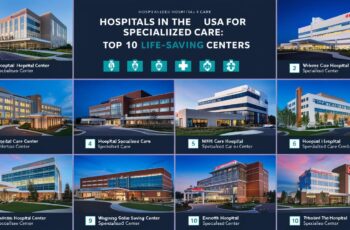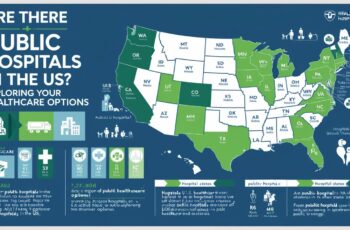Hospitals are crucial for healthcare in the United States. They provide essential services.
In the United States, hospitals vary widely. Some are small community centers, while others are large teaching hospitals. They can be public or private, and their services range from basic care to advanced treatments. Understanding these differences helps patients make informed decisions.
It also highlights the strengths and weaknesses in the healthcare system. This blog post will explore the characteristics and roles of different hospitals in the United States. By the end, you’ll have a clearer picture of the hospital landscape in the country. Let’s dive in and learn more about these vital institutions.
Credit: www.statista.com
Innovative Medical Technologies
Innovative medical technologies are transforming healthcare in the United States. Hospitals now use advanced tools and methods to provide better care. These innovations help diagnose diseases accurately and treat patients effectively.
Advanced Diagnostic Tools
Modern hospitals use advanced diagnostic tools to identify health issues early. These tools include high-resolution imaging machines. They create detailed pictures of the inside of the body. This helps doctors spot problems quickly. Another example is molecular diagnostics. This technology analyzes genes and proteins. It can detect diseases at a very early stage.
Cutting-edge Treatment Options
Hospitals offer cutting-edge treatment options for various conditions. One example is robotic surgery. Surgeons use robots to perform precise operations. This leads to smaller cuts and faster recovery. Another example is personalized medicine. It tailors treatments based on a patient’s genetic makeup. This approach increases the chances of success and reduces side effects.
Patient-centered Care Models
Most hospitals in the United States are adopting patient-centered care models. These models prioritize the needs and preferences of patients. They aim to provide personalized and holistic care. This approach ensures that patients receive the best possible treatment and support.
Personalized Treatment Plans
Personalized treatment plans are a key component of patient-centered care. Doctors create these plans based on individual patient needs. This ensures that each patient gets the care tailored to their specific condition. It also considers their unique medical history and personal preferences. Personalized plans improve patient outcomes and satisfaction.
Holistic Care Approaches
Holistic care approaches focus on treating the whole person, not just the disease. This includes addressing physical, emotional, and social needs. By considering all aspects of a patient’s life, doctors provide more comprehensive care. This approach helps patients feel more supported and cared for.
Holistic care often involves a team of healthcare providers. This team may include doctors, nurses, therapists, and social workers. Each team member brings their expertise to the patient’s care plan. This collaborative approach ensures that all patient needs are met.
Highly Skilled Medical Staff
Most hospitals in the United States boast highly skilled medical staff. Their expertise and dedication ensure patients receive the best care possible. These professionals undergo rigorous training and continuous education to stay updated. Their commitment to excellence makes a significant difference in patient outcomes.
Expert Physicians And Surgeons
Hospitals in the U.S. employ top-notch physicians and surgeons. These experts specialize in various medical fields. They bring years of experience and deep knowledge to their practice. Their skills and precision help in successful diagnoses and treatments. Patients can trust these professionals with their health.
Surgeons perform complex procedures with confidence. They use advanced techniques and state-of-the-art equipment. This ensures the highest level of care during surgeries. Physicians and surgeons work together to provide comprehensive treatment plans. This teamwork enhances the quality of patient care.
Continual Professional Development
Medical staff in U.S. hospitals engage in continual professional development. They attend workshops, seminars, and training sessions regularly. This helps them stay current with the latest medical advancements. Continuous learning is essential in the medical field. It ensures that healthcare providers offer the best possible care.
Hospitals support their staff in pursuing further education. This includes advanced degrees and specialized certifications. Such initiatives foster a culture of lifelong learning. Patients benefit from the up-to-date knowledge of their caregivers. This commitment to education is evident in the high standards of care provided.
Credit: www.businesswire.com
Comprehensive Health Services
Most hospitals in the United States offer a wide range of health services. These services cover everything from routine check-ups to emergency care. Hospitals aim to keep their communities healthy by offering many different kinds of medical support. Let’s take a closer look at some of these services.
Preventative Care Programs
Preventative care programs are essential. They help people avoid getting sick in the first place. These programs include:
- Vaccinations
- Screenings for diseases like cancer and diabetes
- Health education classes
For example, last year my local hospital offered free flu shots. It was a simple way to keep people healthy during flu season. Preventative care saves lives and money. It’s like fixing a small leak before it becomes a big flood.
Specialized Medical Departments
Hospitals also have specialized departments. These departments focus on specific types of care. Some common departments include:
- Cardiology: Heart health
- Oncology: Cancer treatment
- Pediatrics: Children’s health
I remember visiting a pediatric department when my niece was born. The doctors and nurses were experts in caring for babies. They made sure my niece got the best care possible.
Each department has specialists who know their field very well. These experts use the latest technology and treatments. The goal is to provide the best care for every patient. So, whether you need a heart check-up or cancer treatment, hospitals have the right people and tools to help you.
In summary, hospitals in the U.S. are equipped to handle a wide range of health needs. They offer preventative care to keep you healthy and specialized departments for any specific issues. Next time you visit a hospital, take a moment to appreciate the many services they provide. They are there to support you every step of the way.
State-of-the-art Facilities
Most hospitals in the United States feature state-of-the-art facilities. These facilities ensure patients receive the best care possible. Modern technology and equipment enhance treatment outcomes. Hospitals constantly invest in upgrading their infrastructure. This commitment leads to improved patient experiences.
Modern Hospital Infrastructure
Hospitals have modern infrastructures that support advanced medical care. They use cutting-edge technology to diagnose and treat patients. The design of these hospitals focuses on patient comfort and safety. Efficient layouts minimize the risk of infections. It also speeds up recovery times.
Hospitals have spacious rooms with advanced monitoring systems. These systems allow continuous tracking of vital signs. Patients feel more secure with immediate responses to their needs. The infrastructure also includes advanced imaging facilities. These facilities provide clear and precise diagnostic images.
Advanced Surgical Suites
Advanced surgical suites are a hallmark of top hospitals. These suites have the latest surgical tools and technology. Surgeons perform complex procedures with greater precision. This leads to faster recovery and better outcomes for patients. The environment in these suites is sterile and controlled.
Surgeons can access real-time data during operations. This helps them make informed decisions quickly. Modern surgical suites also support minimally invasive techniques. These techniques reduce pain and shorten hospital stays. Patients benefit greatly from these advanced surgical environments.
Patient Safety Initiatives
Patient safety is a top priority for hospitals in the United States. These institutions implement various initiatives to protect patients. These efforts reduce risks and improve care quality. Let’s explore some key patient safety initiatives.
Infection Control Measures
Hospitals have strict infection control measures. These measures prevent the spread of harmful bacteria and viruses. Staff members follow hygiene protocols. They wash hands frequently and use sanitizers. Rooms and equipment are regularly cleaned and disinfected. Protective gear like gloves and masks are mandatory. These steps ensure a safer environment for patients.
Medication Safety Protocols
Medication errors can be dangerous. Hospitals adopt medication safety protocols to avoid mistakes. Electronic prescribing systems are used. These systems reduce errors in medication orders. Pharmacists review prescriptions for accuracy. Nurses double-check medications before administration. Barcoding systems match patients with their correct medications. These protocols protect patients from harmful medication errors.
Collaborative Care Teams
Collaborative care teams are a cornerstone in most hospitals in the United States. These teams ensure that patients receive comprehensive and coordinated care. The approach involves a diverse group of healthcare professionals. Each member brings unique skills and perspectives. This teamwork leads to better health outcomes and patient satisfaction.
Interdisciplinary Teamwork
Interdisciplinary teamwork involves professionals from different healthcare fields. Doctors, nurses, pharmacists, and therapists work together. They share information and collaborate on treatment plans. This reduces medical errors and improves patient care. Each team member contributes their expertise. This collaboration ensures that all aspects of a patient’s health are considered.
Integrated Patient Care
Integrated patient care means seamless coordination of services. It focuses on the whole patient, not just a single issue. This approach includes physical, emotional, and social health. Care teams create personalized plans for each patient. They track progress and make adjustments as needed. This leads to more efficient and effective healthcare delivery.
Community Outreach Programs
Community outreach programs play a vital role in hospitals across the United States. These programs aim to improve the health and well-being of local communities. They provide valuable resources and support to those who need it most. Hospitals use these programs to connect with people outside their walls. This helps build trust and encourages healthier lifestyles.
Health Education Workshops
Health education workshops are a key part of community outreach. They offer information on various health topics. These workshops cover nutrition, exercise, mental health, and disease prevention. Experts lead the sessions. They share their knowledge and answer questions. These workshops help people make informed decisions about their health. They also provide practical tips for daily life.
Free Medical Screenings
Free medical screenings are another important aspect. Hospitals offer screenings for blood pressure, cholesterol, diabetes, and other conditions. These screenings help detect health issues early. Early detection can lead to better outcomes. It also reduces the cost of treatment. People who cannot afford regular check-ups benefit the most. Free screenings make healthcare accessible to everyone.
Credit: www.statista.com
Frequently Asked Questions
What Are Most Hospitals In The United States?
Most hospitals in the United States are private, non-profit institutions. They provide a wide range of medical services.
Are Most Hospitals In The United States Voluntary Hospitals?
Yes, most hospitals in the United States are voluntary hospitals. They operate as non-profit organizations.
What Is The Most Common Type Of Hospital In The United States?
The most common type of hospital in the United States is the acute care hospital. These facilities provide short-term treatment for severe injuries or episodes of illness, urgent medical conditions, and recovery from surgery.
Are Most Hospitals In The United States Government Hospitals?
Most hospitals in the United States are not government hospitals. They are privately owned or part of nonprofit organizations.
Conclusion
Hospitals in the United States play a crucial role. They provide essential care and services. Each hospital strives to offer quality healthcare. Challenges exist, but improvements continue. Patients rely on these institutions for their well-being. Understanding the hospital system helps in making informed choices.
Your health is important; choose wisely. Remember, good care leads to better outcomes. Stay informed and proactive about your health.

